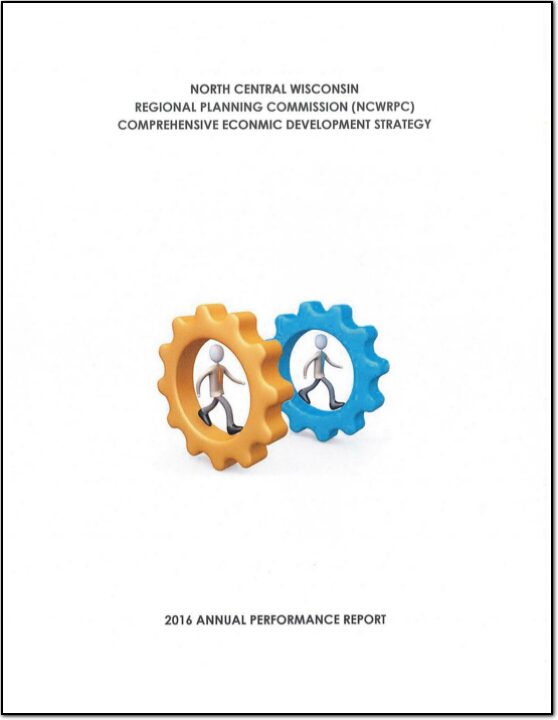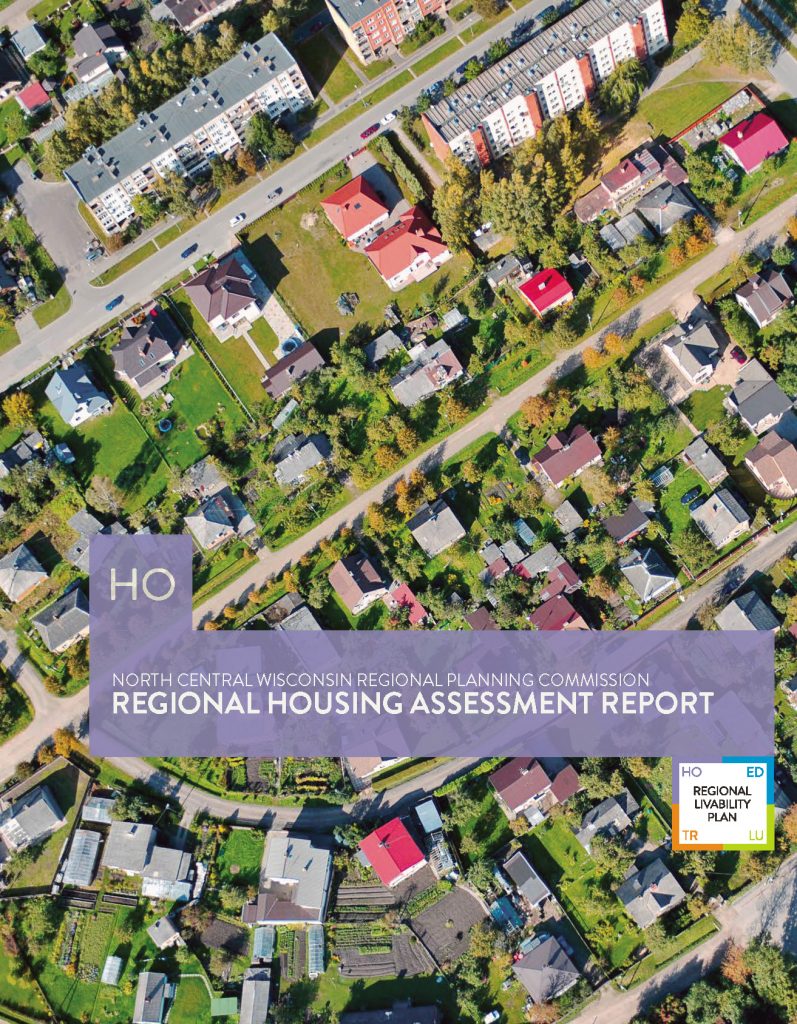The Annual Report is prepared to provide interested local, state, and federal officials as well as citizens with an overview of the activities undertaken by the NCWRPC over the last year. The report highlights our five core work areas:
• Economic Development
• Geographic Information Systems
• Intergovernmental Cooperation
• Land Use, and
• Transportation
In addition, the report meets the requirements as outlined in Wisconsin Statute 66.0309(8)(b) for annual report preparation. This is our 44th Annual Report. With your continued support, we look forward to another successful year in 2018.
Comprehensive Economic Development Strategy 2017
An assessment of economic development activities of the North Central Wisconsin Regional Planning Commission over the last decade and the past year. The report’s seven sections describe the CEDS Committee, Past Year’s Activities, the Physical Region, Changes in the Region’s Population, changes in the Region’s Economy, a Regional Development Strategy, and an Economic Development Work Plan. Also included is a list of potential public works projects. This CEDS process maintains the Region’s eligibility as an Economic Development District (EDD) with the U.S. Economic Development Administration. The District consists of ten counties. These counties are Adams, Forest, Juneau, Langlade, Lincoln, Marathon, Oneida, Portage, Vilas, and Wood. However, Portage, and Wood Counties do not fully participate in the EDD – only some local communities with these two Counties participate.

Annual Report 2016
The Annual Report is prepared to provide interested local, state, and federal officials as well as citizens with an overview of the activities undertaken by the NCWRPC over the last year. The report highlights our five core work areas:
• Economic Development
• Geographic Information Systems
• Intergovernmental Cooperation
• Land Use, and
• Transportation
In addition, the report meets the requirements as outlined in Wisconsin Statute 66.0309(8)(b) for annual report preparation. This is our 43rd Annual Report. With your continued support, we look forward to another successful year in 2017.
Comprehensive Economic Development Strategy 2016 Annual Performance Report
An assessment of economic development activities of the North Central Wisconsin Regional Planning Commission over the last decade and the past year. The report’s seven sections describe the CEDS Committee, Past Year’s Activities, the Physical Region, Changes in the Region’s Population, changes in the Region’s Economy, a Regional Development Strategy, and an Economic Development Work Plan. Also included is a list of potential public works projects. This CEDS process maintains the Region’s eligibility as an Economic Development District (EDD) with the U.S. Economic Development Administration. The District consists of ten counties. These counties are Adams, Forest, Juneau, Langlade, Lincoln, Marathon, Oneida, Portage, Vilas, and Wood. However, Portage, and Wood Counties do not fully participate in the EDD – only some local communities with these two Counties participate.

Transportation Assessment Report – Regional Livability Plan
The Transportation Assessment Report is one of four reports prepared as part of the overall Regional Livability Plan effort undertaken by the North Central Wisconsin Regional Planning Commission. Each Assessment Report focuses on the foundational topics of Housing, Economic Development, Transportation, and Land Use. These four reports along with demographic data will form the basis of the overall North Central Wisconsin Regional Livability Plan.
Transportation is a crucial component of livability and provides a basis for the formulation of policy to coordinate transportation facilities with a sustainable pattern of development. This Assessment Report examines transportation on a regional scale. The existing network, from roads to rails, needs to be coordinated to maximize efficiency for the overall system. The connection between home and work is an important part of any transportation system. A range
of transportation alternatives should be supported, including walkability wherever possible. Perhaps the greatest challenge in the North Central Wisconsin Region is in developing an efficient and cost effective rural transportation system to serve what is likely to be the continuing trend of development of second and retirement homes in amenity-
rich rural areas.

Land Use Assessment Report – Regional Livability Plan
The Land Use Assessment Report is one of four reports prepared as part of the overall Regional Livability Plan effort undertaken by the North Central Wisconsin Regional Planning Commission. Each Assessment Report focuses on the foundational topics of Housing, Economic Development, Transportation, and Land Use. These four reports along with demographic data will form the basis of the overall North Central Wisconsin Regional Livability Plan.
This Assessment Report examines land use on a regional scale. Land Use is a crucial component of livability and provides a basis for the formulation of policy to coordinate a sustainable pattern of development. The existing natural landscape, land use patterns and demographic projections are all examined as they influence future land use and development. Much of the Region has population and housing densities well below the state average, which in turn places more reliance on automobiles to get to and from work, shopping and other activities. In addition, within the ten counties that make up the Region there are 198 towns, 39 villages, 21 cities and 4 tribal nations. All of these communities have an impact on the development of the region.

Housing Assessment Report – Regional Livability Plan
The Housing Assessment Report is one of four reports prepared as part of the overall Regional Livability Plan effort undertaken by the North Central Wisconsin Regional Planning Commission. Each Assessment Report focuses on the foundational topics of Housing, Economic Development, Transportation, and Land Use. These four reports along with demographic data will form the basis of the overall North Central Wisconsin Regional Livability Plan.
Housing is a crucial component of livability. The complex dynamics of the housing market impact future housing development. Understanding this relationship provides a basis for the formulation of policy to coordinate transportation facilities with a sustainable pattern of residential development. The connection between home and work is a fundamental function of any transportation system. Home-work connections should be efficient, reinforce and strengthen community ties, and foster economic development and environmental sustainability. Understanding the factors affecting people’s decisions on meeting their housing needs provides a basis for establishing solid home-work connections in the region.

Economic Development Assessment Report – Regional Livability Plan
The Economic Development Assessment Report is one of four reports prepared as part of the overall Regional Livability Plan effort undertaken by the North Central Wisconsin Regional Planning Commission. Each of the Assessment Reports focuses on the foundational topics of Housing, Economic Development, Transportation and Land Use. These four reports along with demographic data will form the basis for the overall Regional Livability Plan in North Central
Wisconsin.
This Assessment Report examines economic development on a regional scale. The business and employment mix, in part, defines the Region. Economic Development is an important component of any planning effort, be it at the local or regional level. Economic Development is a crucial component of livability and impacted by the housing, transportation, and land use of the Region. In addition to explaining the current population, education, and employment
conditions in the Region, this report will also observe projections for the future. Further, this report will study the Region’s economic strengths and weaknesses in the context of industry trends and emerging industry clusters.

Regional Livability Plan
The Regional Livability Plan identifies ways to address the region’s opportunities and weaknesses to become more livable for all residents. The plan addresses four specific areas: Housing, Economic Development, Transportation, and Land Use. The RLP introduces goals, objectives, and recommendations that can help the region use the money we have more effectively and efficiently by investing in solutions that solve multiple problems. Mainly, livable and sustainable developments are less expensive to build, require fewer municipal services, result in higher property values, and generate a range of long-term social and environmental benefits.

Annual Report 2015
The Annual Report is prepared to provide interested local, state, and federal officials as well as citizens with an overview of the activities undertaken by the NCWRPC over the last year. The report highlights our five core work areas:
• Economic Development
• Geographic Information Systems
• Intergovernmental Cooperation
• Land Use, and
• Transportation
In addition, the report meets the requirements as outlined in Wisconsin Statute 66.0309(8)(b) for annual report preparation. This is our 42th Annual Report. With your continued support, we look forward to another successful year in 2015.